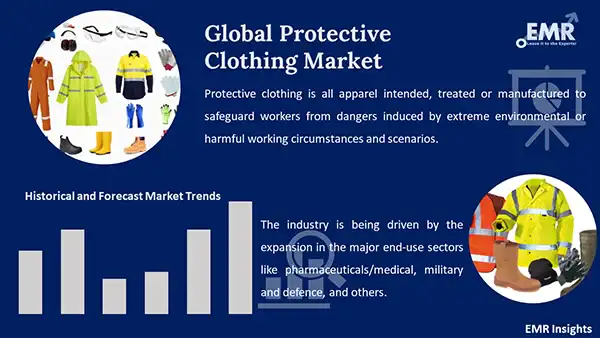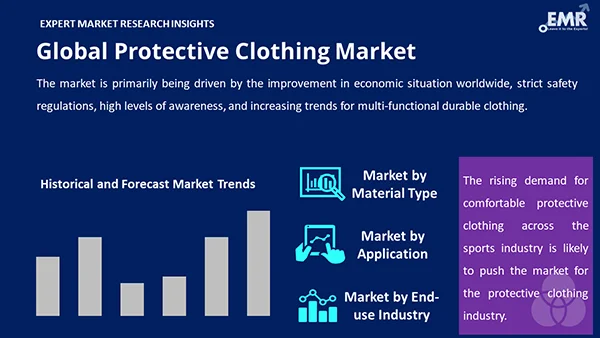
Consumer Insights
Uncover trends and behaviors shaping consumer choices today
Procurement Insights
Optimize your sourcing strategy with key market data
Industry Stats
Stay ahead with the latest trends and market analysis.
The global protective clothing market attained a value of about USD 10.12 Billion in 2025. The market is further expected to grow in the forecast period of 2026-2035 at a CAGR of 5.70% to reach nearly USD 17.62 Billion by 2035.
Base Year
Historical Period
Forecast Period
Compound Annual Growth Rate
5.7%
Value in USD Billion
2026-2035
*this image is indicative*
The growth of protective clothing industry could be attributed to an improvement in the economic climate and a boom in industrialisation worldwide. Industries use protective gear to safeguard their employees. With the rising pace of industrialisation, the number of production processes and policies has significantly risen, which has led to the development of special protective clothing for personal protection equipment undertakings in order to provide the highest level of health for employees.

Read more about this report - REQUEST FREE SAMPLE COPY IN PDF
In developed and developing countries, the majority of the economies have put organised industrial growth strategies into practise. Over the previous years, new techniques have been developed rapidly. Industrial expansion is expected to increase the demand for protective gear and, thus boosting the market for protective clothing.
As COVID-19 expanded internationally, government efforts to develop and respond to the need for PPE have attained unprecedented heights. National storage plans by the concerned nations continued to boost the need for the protective clothing industry.

Read more about this report - REQUEST FREE SAMPLE COPY IN PDF
Protective clothing is all apparel intended, treated or manufactured to safeguard workers from dangers induced by extreme environmental or harmful working circumstances and scenarios.
The major material types of protective clothing are:
The market can be broadly categorised on the basis of its applications into:
The division on the basis of end-use industry is:
Breakup by Region
A range of needs is met by multi-functioning durable protective gear. The wearer may be protected from one or more dangers by protective clothes. These may include mechanical impact protection, physical damage, heat/fire, cold temperatures, rain, electrical shock, radiation, invisibility and poisonous chemicals and infectious agents. In recent years, a great deal of attention has been paid to the design of novel textiles with multifunctional activities and property in order to improve the characteristics of materials for various purposes.
As conventional protective garments provide obstacles, such as heavy weight, bulky nature, mobility deficiency, thermal stress, limited thermal dissipation, physical stress, decreased dexterity, etc. Credits to the remarkable qualities of the textiles that are enhanced with advanced materials that can be an efficient way to overcome these limits and to increase features like mechanical strength, anti-bacterial activity, flame resistance, conductivity, and UV power. These features being incorporated in protective clothing have positively impacted the growth of the industry.
The report presents a detailed analysis of the following key players in the global protective clothing market, looking into their capacity, market shares, and latest developments like capacity expansions, plant turnarounds, and mergers and acquisitions:
The comprehensive report looks into the macro and micro aspects of the industry. The EMR report gives an in-depth insight into the market by providing a SWOT analysis as well as an analysis of Porter’s Five Forces model.




*While we strive to always give you current and accurate information, the numbers depicted on the website are indicative and may differ from the actual numbers in the main report. At Expert Market Research, we aim to bring you the latest insights and trends in the market. Using our analyses and forecasts, stakeholders can understand the market dynamics, navigate challenges, and capitalize on opportunities to make data-driven strategic decisions.*
Get in touch with us for a customized solution tailored to your unique requirements and save upto 35%!
In 2025, the global protective clothing market attained a value of nearly USD 10.12 Billion.
The market is projected to grow at a CAGR of 5.70% between 2026 and 2035.
The major market drivers include healthy economic growth, the development of special protective clothing for personal protection equipment, and surging stringent regulations to ensure the safety of workers.
The growing awareness regarding the diverse benefits of multi-functioning durable protective gear, the emerging shift towards advanced materials that offer enhanced properties, and rapid industrialisation are the key trends propelling the market demand.
The major regions in the market are North America, Latin America, Europe, the Middle East and Africa, and the Asia Pacific.
The major material types of protective clothing are aramid and blends, polyolefin and blends, polybenzimidazole (PBI), cotton fibres, and laminated polyesters, among others.
The various applications of protective clothing are thermal, mechanical, chemical, and biological/radiation, among others.
Oil and gas, construction and manufacturing, pharmaceuticals/medical, military and defence, and firefighting, among others, are the several end-use industries of protective clothing.
The major players in the market are DuPont de Nemours, Inc., Glen Raven, Inc., Koninklijke Ten Cate B.V., Lakeland Industries Inc., and 3M Company, among others.
Explore our key highlights of the report and gain a concise overview of key findings, trends, and actionable insights that will empower your strategic decisions.
| REPORT FEATURES | DETAILS |
| Base Year | 2025 |
| Historical Period | 2019-2025 |
| Forecast Period | 2026-2035 |
| Scope of the Report |
Historical and Forecast Trends, Industry Drivers and Constraints, Historical and Forecast Market Analysis by Segment:
|
| Breakup by Material Type |
|
| Breakup by Application |
|
| Breakup by End-use Industry |
|
| Breakup by Region |
|
| Market Dynamics |
|
| Competitive Landscape |
|
| Companies Covered |
|
| Report Price and Purchase Option | Explore our purchase options that are best suited to your resources and industry needs. |
| Delivery Format | Delivered as an attached PDF and Excel through email, with an option of receiving an editable PPT, according to the purchase option. |
Datasheet
One User
USD 2,499
USD 2,249
tax inclusive*
Single User License
One User
USD 3,999
USD 3,599
tax inclusive*
Five User License
Five User
USD 4,999
USD 4,249
tax inclusive*
Corporate License
Unlimited Users
USD 5,999
USD 5,099
tax inclusive*
*Please note that the prices mentioned below are starting prices for each bundle type. Kindly contact our team for further details.*
Flash Bundle
Small Business Bundle
Growth Bundle
Enterprise Bundle
*Please note that the prices mentioned below are starting prices for each bundle type. Kindly contact our team for further details.*
Flash Bundle
Number of Reports: 3
20%
tax inclusive*
Small Business Bundle
Number of Reports: 5
25%
tax inclusive*
Growth Bundle
Number of Reports: 8
30%
tax inclusive*
Enterprise Bundle
Number of Reports: 10
35%
tax inclusive*
How To Order

Select License Type
Choose the right license for your needs and access rights.

Click on ‘Buy Now’
Add the report to your cart with one click and proceed to register.

Select Mode of Payment
Choose a payment option for a secure checkout. You will be redirected accordingly.
Gain insights to stay ahead and seize opportunities.

Get insights & trends for a competitive edge.

Track prices with detailed trend reports.

Analyse trade data for supply chain insights.

Leverage cost reports for smart savings

Enhance supply chain with partnerships.

Connect For More Information
Our expert team of analysts will offer full support and resolve any queries regarding the report, before and after the purchase.
Our expert team of analysts will offer full support and resolve any queries regarding the report, before and after the purchase.
We employ meticulous research methods, blending advanced analytics and expert insights to deliver accurate, actionable industry intelligence, staying ahead of competitors.
Our skilled analysts offer unparalleled competitive advantage with detailed insights on current and emerging markets, ensuring your strategic edge.
We offer an in-depth yet simplified presentation of industry insights and analysis to meet your specific requirements effectively.
Share